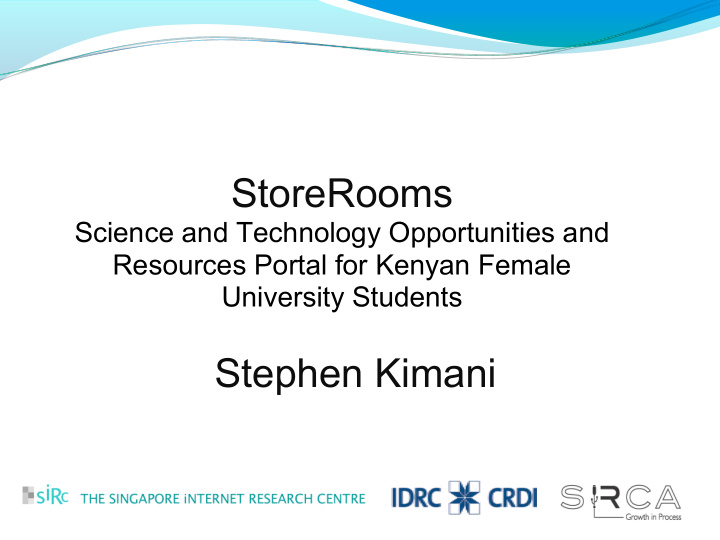



StoreRooms Science and Technology Opportunities and Resources Portal for Kenyan Female University Students Stephen Kimani
Roadmap ● Introduction ● Literature Review ● Research Questions ● Methodology and Progress ● Q & A
Introduction ● In Kenya, it is extremely difficult to attract and retain female students in science and technology courses. ● There are very few female students in Kenya’s institutions of higher learning pursuing science and technology courses. ● The problem could be attributed to factors such as: Lack of information and inaccurate negative image: ○ stereotypes, myths and misconceptions Lack of support from parents and/or guardians ○ Role models and/or influential females in science and ○ technology etc ○
Introduction ● As a girl attempts to pursue higher education, the less support she is likely to get. ● Need to encourage and support female science and technology students in higher institutions of learning. ● Impact of online portals: Positive changes in people's motivation, attitude and ○ behaviour toward health (Webb et al., 2010; Baghaei et al., 2011). Increased learning and flexibility (Liebeskind et al., 1996). ○ ● Paulsenand Bransfield (2009) indicate that, 88% of 631 girls report that the website engineeryourlife.org made them more interested in engineering as a career, and 76% said that it inspired them to take an engineering course.
Introduction ● Thus, online portals could lead to positive changes in female students' motivation, perception and behaviour toward science and technology.
Introduction ● Web has science and technology resources (e.g. e- books, etc) and opportunities (e.g. scholarships, etc): Scattered all over the Web. ○ Not relevant to the specific needs of female science and ○ technology students from developing countries. Contextual challenges in developing countries e.g. limited or ○ unreliable Internet access. ● Important to develop an online portal: Integrated avenue/access. ○ Relevant to female students from developing countries. ○ Address contextual requirements in developing countries. ○ ● Science and Technology Opportunities and Resources Portal for Kenyan Female University Students ( StoreRooms )
Literature Review ● There exist several web-based applications that provide science and technology resources and opportunities e. g. National Science Digital Library, Science, Science Careers, State Science and Technology Institute, etc. While acknowledging the role played by such, they don’t ○ take into account the unique contextual challenges and needs of female students from developing countries. ● Females and technology websites e.g. prigepp.org, catunescomujer.org, wigsat.org, awis.org, engineeryourlife.org. The proposed portal will take into account the unique ○ contextual challenges and specific needs of female science and technology students from Kenya.
Research Questions ● This research project intends to address the following research questions: What are the characteristics and needs of the Kenyan ○ female science and technology students? What kind of tasks do Kenyan female science and ○ technology students normally perform with existing Science and Technology web applications? What is the Kenyan female science and technology ○ students’ attitude or impression toward (or experience when using) existing Science and Technology web applications? What tasks or services would Kenyan female science and ○ technology students want to be offered or supported by the portal?
Methodology and Progress 1. Detailed literature analysis and pilot study Global level : attraction and retention statistics, factors, ● explanations, interventions. National level : attraction and retention statistics, factors, ● explanations, interventions. Pilot study : stakeholders (teachers, parents, guardians, Ministry ● of Education, universities with female science and technology students): their experience, obstacles, solutions/recommendations. Outstanding Women and Technology web applications (web ● designers/administrators): design, sections, objectives, services/features, lessons learned, recommendations.
Methodology and Progress 2. Collection and analysis of requirements Iterative evaluations by HCI experts and users, and ● corresponding refining/improving of design. Determine online requirements of Kenyan female science and ● technology students. Questionnaire-based study (Kenyan female science and ● technology students): 2 public universities and 3 private universities.Collect data ○ inline with research questions. Structure of questionnaire: biodata, reasons why it is difficult to ○ attract/retain, suggested solutions, characteristics and needs, tasks/services, impression. Obtained results and requirements => online portal ○ requirements specification.
Methodology and Progress 3. Design, evaluation and implementation Use the realized requirements to develop an appropriate portal. ● Three main components: the client, the application layer, and ● the data layer. Iterative evaluations by HCI experts and users, and ● corresponding refining/improving of design. Final evaluation to get students’ feedback and perception ● regarding the realized portal.
Q & A
References ● Baghaei et al. (2011). Engaging Families in Lifestyle Changes Through Social Networking. International Journal of Human Computer Interaction. 27(10). ● Liebeskind et al. (1996). Social Networks, Learning, and Flexibility: Sourcing Scientific Knowledge in New Biotechnology Firms. Organization Science. 7(4), July– August 1996. ● Webb et al. (2010). Using the Internet to Promote Health Behaviour Change: A Systematic Review and Meta- analysis of the Impact of Theoretical Basis, Use of Behaviour Change Techniques, and Mode of Delivery on Efficacy. Journal of Medical Internet Research, 12.
Recommend
More recommend